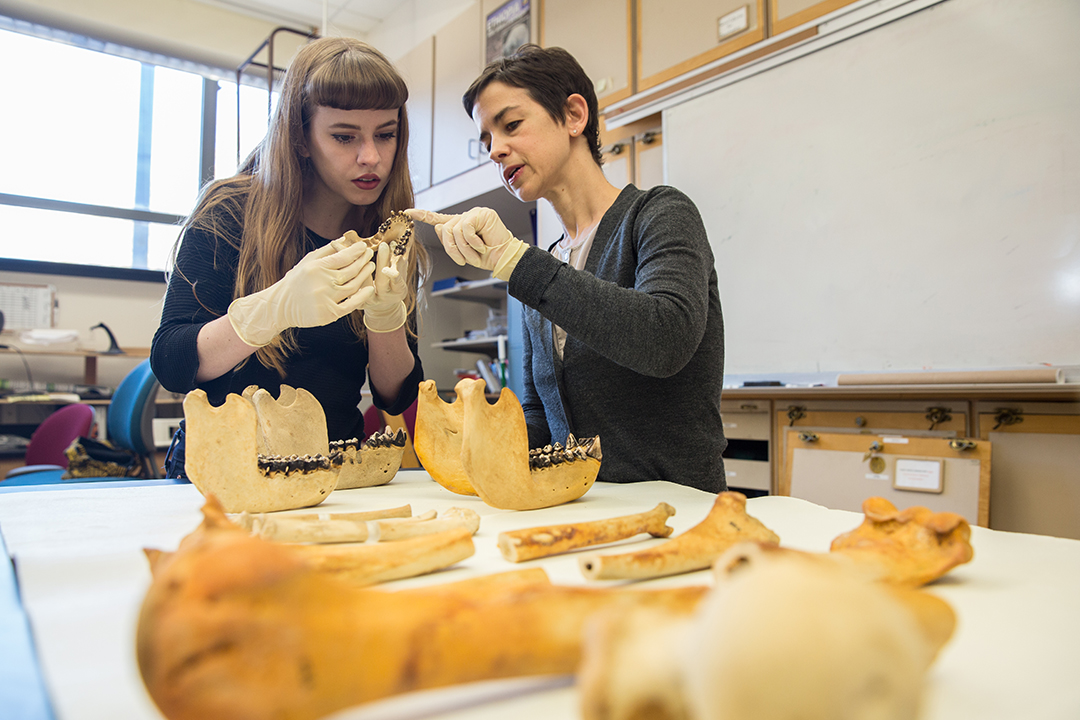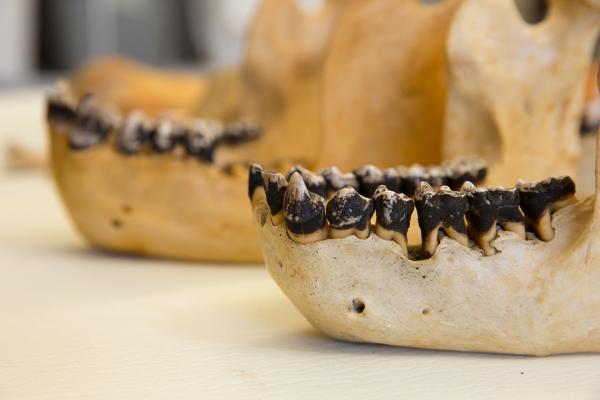By John DiConsiglio
In the lush green valley of Rwanda's Virunga Mountain range, nestled in the shadow of twin volcano peaks, lies a graveyard like no other on earth. The carefully-tended field is covered by rocks and grass. Its plots are marked by simple stones and wooden stakes.
But these graves were never intended to remain undisturbed. On summer mornings, it’s not unusual to find scientists and researchers—including Assistant Professor of Anthropology Shannon McFarlin and her graduate students—with shovels and picks in hand, digging through layers of dirt and unearthing makeshift coffins or loose bones in the ground.
The scene isn’t as macabre as it sounds. This is a gorilla graveyard. At any one time, it’s the resting place for a dozen or more mountain gorillas, the world’s largest primates and one of humankind’s closest genetic relatives. It holds the remains of 400-pound silverbacks and infant apes of less than 10 pounds—victims of everything from respiratory disease to losing battles with bigger gorillas to poachers’ traps set for antelopes and other forest animals. By excavating and examining their bones, McFarlin, her students and a multi-disciplinary team of scientists and researchers from Rwanda and the U.S. are uncovering clues that could help save these gorillas from extinction, while also contributing to the understanding of human evolution.
“The depth of information associated with these skeletons is extraordinary,” said McFarlin, assistant professor of anthropology at Columbian College’s Center for the Advanced Study of Human Paleobiology. “We can read the bones and teeth as a record of the animal’s life. They are essentially a catalog of everything that the gorilla experienced, from birth to death.”
The graves and bones are just one part of a unique project spearheaded by McFarlin and research partners throughout Africa and the U.S. Dubbed the Mountain Gorilla Skeletal Project, the multi-disciplinary initiative is based in the Karisoke Research Center—the same field site where anthropologist Dian Fossey lived with great apes for 20 years.
Long before McFarlin and her students arrived at Karisoke with their tools of the trade, Rwandan trackers hiked into the Virunga hills to observe the activities of living gorillas. (Some of the oldest apes were once studied by Fossey herself.) The trackers recorded everything from the animals’ diet and social habits to their illnesses, broken bones and the infanticide that is common among gorilla groups. At the same time, veterinarians helped maintain the gorillas’ health with check-ups and treatment.
Since the onset of the project in 2008, apes have been buried in the center’s graveyard, following meticulous interment protocols. Anywhere from six months to a year after the animals’ deaths, McFarlin’s team exhumes the skeletons—providing an unprecedented opportunity to compare the gorilla bones with the apes’ recorded life history. The result: a unique snapshot of the effects of socioecology, stress and environmental factors on the gorillas’ skeletal development.
“Think of this as a controlled experiment: We have the bones. We have the records. We match them together and study the link between behavior and biology,” said second-year anthropology graduate student Meredith Killough. “It gives us a unique opportunity to test assumptions that have existed for decades about development and the relationships between behavior and ecology.”
Endangered Gorillas
McFarlin co-directs the Mountain Gorilla Skeletal Project with Dr. Antoine Mudakikwa, chief veterinarian from the Rwanda Development Board–Tourism and Conservation. The project’s other core partners include the New York University College of Dentistry, the Dian Fossey Gorilla Fund International-Karisoke Research Center and the Mountain Gorilla Veterinary Project. The Smithsonian National Museum of Natural History and the University of Indianapolis also made important contributions to the project.Led by an international team of anthropologists, conservationists, veterinarians and forensic scientists, the project has yielded the largest collection of mountain gorilla skeletal remains in the world—115 individual animals. Since 2009, McFarlin has brought GW graduate students to the site for summer research excursions that collect skeletal data on the historically under-studied gorilla population.
“It’s crazy, but we know almost nothing about [the physical growth and development of] great apes in the wild,” said Kate McGrath, a third-year doctoral student in human paleobiology. Indeed, virtually all existing scientific data on the physical and anatomical characteristics of gorillas is derived from apes in captivity or poorly documented museum collections. That method has sharp limitations—not the least of which is the fact that there are no mountain gorillas in captivity. And captive ape studies don’t reflect natural conditions, like seasonal variabilities, food supply issues and interactions with social groups.
But studying gorillas in the wild has shortcomings as well. Mountain gorillas are critically endangered, with only 900 surviving in the wild, mostly in Rwanda, Uganda and the Democratic Republic of Congo. The apes face threats like habitat loss, poachers’ snares and diseases transmitted by humans.
And the research center itself has faced adversity. Amid the Rwandan civil war, Karisoke was evacuated five times, destroyed three times and rebuilt twice. Many trackers lost their homes. Some were imprisoned; others saw family members murdered. Remarkably, the staff continued to monitor the gorillas during the nation’s violent strife. In fact, thanks to the Karisoke conservation efforts, the Virunga gorillas are the only great ape species to increase in number, growing by more than 40 percent since 1989.
“The importance of this project, not only for studying human evolution but also for protecting the mountain gorilla population, cannot be overstated,” McGrath said.
Digging for Clues
 McFarlin and her students have spent nearly every summer since the project’s inception laboring in the gorilla graveyard. Excavating the bones is a back-breaking process. The first step is rolling heavy boulders off each plot. Then, fighting spiders and mosquitoes, the crew digs through hardened topsoil. As they near the apes’ remains, they carefully sweep away layers of dirt with increasingly finer instruments— first garden trowels, then wooden spoons, then tweezers. Each bone is painstakingly measured and recorded. The researchers often spend hours delicately flicking dirt into dust pans to sift for stray bones.
McFarlin and her students have spent nearly every summer since the project’s inception laboring in the gorilla graveyard. Excavating the bones is a back-breaking process. The first step is rolling heavy boulders off each plot. Then, fighting spiders and mosquitoes, the crew digs through hardened topsoil. As they near the apes’ remains, they carefully sweep away layers of dirt with increasingly finer instruments— first garden trowels, then wooden spoons, then tweezers. Each bone is painstakingly measured and recorded. The researchers often spend hours delicately flicking dirt into dust pans to sift for stray bones.
“It’s incredibly grueling,” said McGrath, who notes that each grave can take as long as two days to excavate. “I don’t have many friends who spend their summers in a termite-filled ditch, digging up massive gorilla skeletons with a spoon.”
Most of the bones remain at the Karisoke center to build local capacity and promote the region’s research opportunities. Some bones found during the digs are on loan to McFarlin’s hard tissue lab, which will soon reside in the new Science and Engineering Hall. McGrath is among those examining the bones; she looks at how stress experienced during the animals’ lives is recorded in its enamel defects.
“As teeth grow, they produce lines across the enamel, not unlike tree rings,” she said. An interruption in the growth line indicates a stressful event in the gorilla’s life. Comparing the growth line disturbance to the ape’s recorded history, McGrath hopes to pin the defect to an exact event in the gorilla’s life. In concept, McGrath explained, her research will allow her to “look at the teeth and say, okay, ‘Jimmy’ experienced stress at 2.02 years of age. Then I go back into the record and see that he got caught in a snare at 2.02 years.”
Research by McFarlin’s team also involves examining fist-sized gorilla vertebrae for clues to the roots of arthritis, the focus of Killough’s work; and post-doctoral scientist Jordi Galbany is using photogrammetry—a new technique that records physical characteristics using cameras, distance meters and calibrated laser pointers—to collect the first reliable measurements of living mountain gorillas in the wild.
“We are at the intersection of evolutionary studies, anthropology and conservation,” said McFarlin. “It’s an exciting place to be.”
Above right: McFarlin’s students study gorilla jaws for clues to teeth defects.
Above left: The skeletal bones of gorillas uncovered during McFarlin’s digs are on loan to her hard tissue lab.



